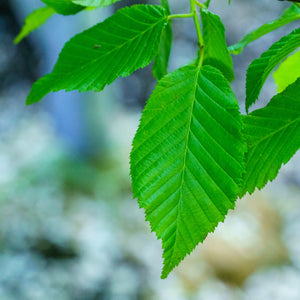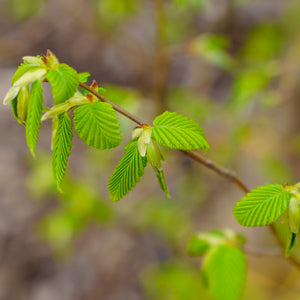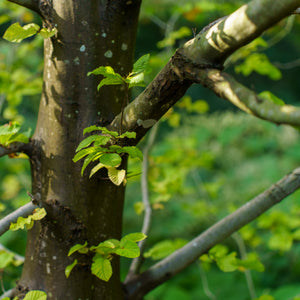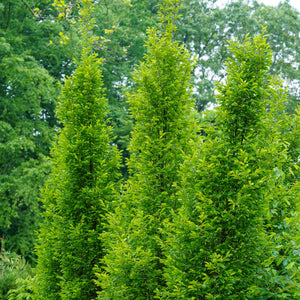The Hornbeam Guide
Hornbeam trees (genus Carpinus) are elegant, finely textured deciduous trees prized for their sculptural form, adaptability, and year-round landscape presence. With options ranging from upright columnar forms to broad shade trees and native understory species, hornbeams offer excellent versatility in both formal and naturalistic designs. Their dense branching, smooth gray bark, and golden fall color make them valued for structure, privacy, and beauty in all seasons.
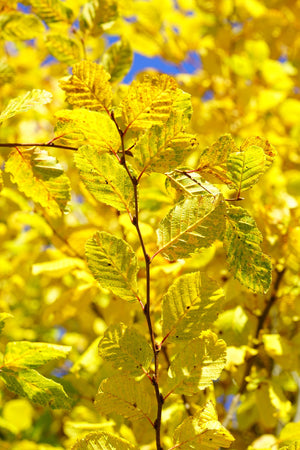
About
Hornbeams fall into two broad species used in landscaping: the European hornbeam (Carpinus betulus) and the American hornbeam (Carpinus caroliniana), also known as musclewood or ironwood.
Carpinus betulus, native to Europe and Western Asia, is widely planted for its formal aesthetic and architectural form. Cultivars like:
- ‘Frans Fontaine’ – Narrow, upright form ideal for street or screen planting.
- ‘Fastigiata’ – Classic pyramidal shape with dense branching.
- ‘Columnaris Nana’ – A compact, slow-growing dwarf ideal for small spaces or low hedges.
- ‘Monument’ and ‘Pinocchio’ – Lesser-known cultivars selected for symmetry and tidy habits.
Carpinus caroliniana, the American hornbeam, is native to the eastern U.S. and valued for its smooth, sinewy gray bark and tolerance of shade. It's typically found in woodlands and along streambanks, and cultivars like ‘J.N. Upright’ offer a more structured, columnar habit for formal use.
Both species are slow to medium growers, offer reliable fall color in shades of gold and orange, and hold onto their dried leaves through winter in youth or hedged forms—offering privacy even when dormant. Their durability, tolerance to pruning, and refined form have made hornbeam a favorite for everything from street trees to clipped garden walls.
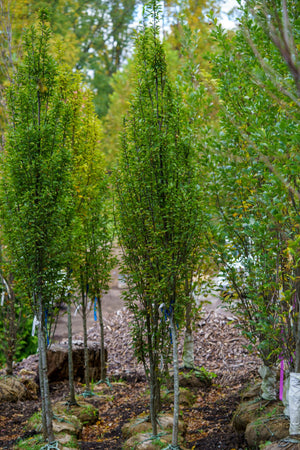
PLANTING
Hornbeam thrives in a wide range of conditions when properly sited and planted.
USDA Hardiness Zones:
- Carpinus betulus: Zones 4–8
- Carpinus caroliniana: Zones 3–9
Soil: Prefers well-drained, loamy soil but tolerates clay and sandy soils. Slightly acidic to neutral pH is best. Avoid prolonged soggy or compacted soils.
Sunlight: Grows well in full sun to partial shade. American hornbeam is more shade tolerant, making it a good option for woodland edges or understory plantings.
Watering: Water regularly during establishment. Once mature, hornbeam is moderately drought-tolerant but benefits from occasional deep watering during dry periods.
Spacing:
- For hedges or screens: space upright varieties 4–6 feet apart.
- For individual trees or focal points: space 20–30 feet apart depending on cultivar and mature size.
Planting Time: Plant in early spring or fall when soil temperatures are moderate and moisture is more reliable.

CARE
Hornbeam is low-maintenance once established and responds well to both natural growth and formal pruning.
Watering: Deeply water during dry spells, especially in the first 2–3 years. Avoid allowing soil to remain soggy for extended periods.
Fertilizing: Generally not needed in fertile soils. If necessary, apply a slow-release balanced fertilizer in early spring.
Pruning: One of the most pruning-tolerant trees available. Can be pruned into formal shapes or left to grow naturally. Best pruned in late winter before bud break or immediately after leaf drop in fall. Avoid heavy pruning in midsummer.
Pests & Diseases: Rarely troubled by pests or disease. May experience minor issues with leaf spot or aphids, but these are not typically harmful.
Mulching: Apply 2–3 inches of mulch around the base to retain moisture and moderate soil temperature. Keep mulch away from the trunk flare.
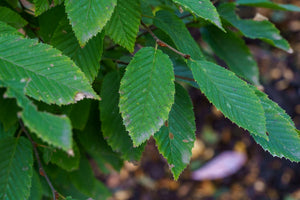
HOW TO USE
Hornbeam’s adaptability and refined appearance make it a valuable structural element in both traditional and contemporary landscapes. Whether clipped into hedges or planted as specimens, hornbeams bring year-round interest and enduring form.
Focal Point: Upright cultivars like ‘Frans Fontaine’ or ‘Fastigiata’ are excellent as vertical focal points in formal gardens, driveways, or urban courtyards. Their strong central leader and symmetrical branching provide vertical architecture and visual rhythm in both leaf and bare form.
Privacy Screens and Hedges: European hornbeam is one of the best trees for formal hedging. Dense branching and leaf retention into winter provide year-round screening. Plant closely and shear annually to maintain shape. Use in place of boxwood or yew for a taller, hardier option.
Street and Urban Trees: With high salt and pollution tolerance, hornbeam makes a durable street tree. Use narrow forms like ‘Frans Fontaine’ or ‘J.N. Upright’ along sidewalks, medians, or building edges where space is limited but height is desired.
Shade Trees: American hornbeam is an excellent choice for smaller landscapes needing a medium-height shade tree. Its spreading canopy, native adaptability, and attractive bark make it ideal for naturalized or suburban settings.
Woodland Edges and Naturalized Plantings: Plant American hornbeam in mixed borders with redbuds, dogwoods, or serviceberries. Its shade tolerance makes it ideal for transition areas between sun and woodland.
Formal and Classical Gardens: Hornbeam lends itself to clipped allees, pleached panels, or geometric parterres. Use as a vertical backdrop or clipped wall to add structure and symmetry.
Companion Planting: Pair with evergreen shrubs like hollies or boxwoods, underplant with hellebores, ferns, epimedium, or ornamental grasses. In formal designs, combine with clipped lavender, catmint, or low-growing perennials for contrast and rhythm.
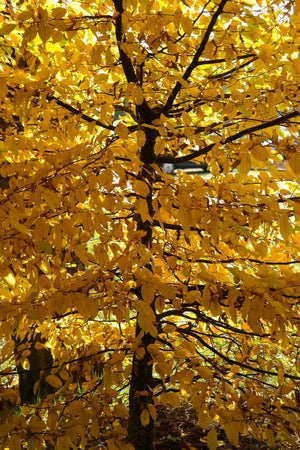
Common Questions
How big do hornbeam trees grow? European hornbeams typically reach 40–60 feet tall with a spread of 30–40 feet. Upright cultivars like ‘Frans Fontaine’ may stay 35 feet tall and 15–20 feet wide. American hornbeam grows 20–30 feet tall and wide.
How far apart should I plant hornbeams? For hedges or screens, space 4–6 feet apart depending on cultivar and desired density. For specimen planting, allow 20–30 feet between trees to accommodate mature spread.
How fast do hornbeam trees grow? Hornbeams are slow to moderate growers, typically adding 12–18 inches per year. Upright cultivars may grow slightly faster in early years if well watered and sited in full sun.
How tall do hornbeam trees grow? Mature heights vary by species and cultivar. Large European hornbeams may reach 60 feet; columnar forms stay under 40 feet. American hornbeam usually tops out at 30 feet.
Are American hornbeam trees messy? No. Hornbeams produce small, inconspicuous seeds and drop their leaves cleanly in fall. Some varieties may retain dry leaves into winter, which can be beneficial for privacy and structure.
Are hornbeams evergreen? No. Hornbeams are deciduous. However, they often retain dried leaves through winter on younger trees or when clipped into hedges, giving them semi-evergreen visual value.
Can I prune a hornbeam in the winter? Yes. Late winter, while the tree is dormant, is an ideal time for structural pruning. Avoid pruning in late summer or during extreme heat to prevent stress.
Do deer eat hornbeam? Hornbeam is generally deer-resistant. While no plant is deer-proof, it is not a preferred food and is rarely damaged even in high-pressure areas.
Do hornbeam trees lose their leaves? Yes. Hornbeam is deciduous and drops its leaves in fall. However, many trees—especially European hornbeam hedges—will retain their dry, tan foliage into late winter or early spring.
Conclusion
Hornbeam is a graceful, resilient, and adaptable tree suited for a wide range of uses—from stately focal points and formal hedges to naturalized woodland borders and urban streetscapes. With both native and European species offering variations in form and function, hornbeam delivers year-round structure, subtle seasonal beauty, and long-term reliability in gardens and public spaces alike.
The Hornbeam Collection
Sold Out

